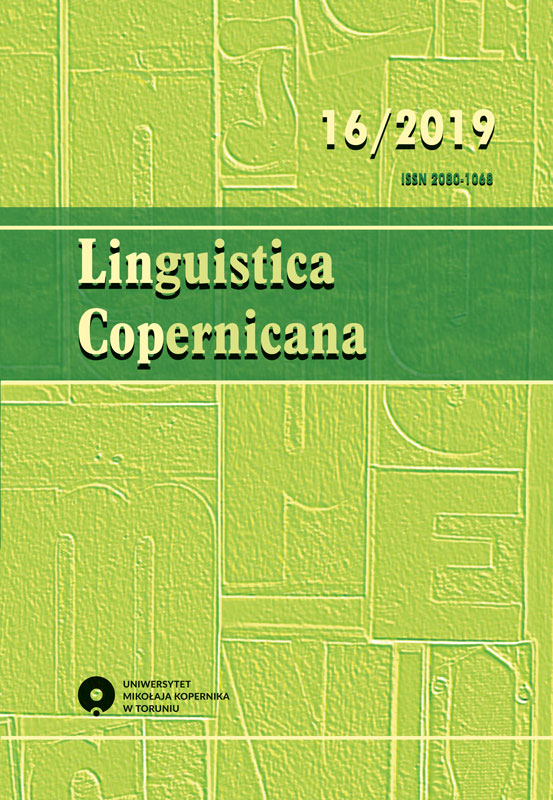Morphological derivation in Belarusian-Russian and Ukrainian-Russian mixed speech
DOI:
https://doi.org/10.12775/LinCop.2019.013Keywords
Belarusian-Russian Mixed Speech, Ukrainian-Russian Mixed Speech, derivational morphologyAbstract
The article dwells upon reasons that may lay behind the differences between word formation in Belarusian-Russian and Ukrainian-Russian Mixed Speech (BRMS and URMS). Taking into account some derivational phenomena, I demonstrate which affixes (‘Russian’ or ‘Belarusian’/’Ukrainian’) are more preferable. Under scrutiny are also sociodemographic and structural factors that influence on the choice of affixes.
Comparison of BRMS and URMS demonstrates the difference in the morphology of these mixed idioms. While in Belarusian Mixed Speech more often are ‘Russian’ suffixes, in URMS they prevail only in some cases, semantically triggered. The most important difference is the fact that ‘Ukrainian’ suffixes in URMS are sometimes even more preferable as a more “prestigious” variant due to the higher status of Ukrainian language in Ukraine.
The role of such sociolinguistic factors as rural-urban migration and the age of the informants is minimal, however by non-migrants and younger people the tendency toward the use of ‘Russian’ suffixes is stronger. In both idioms an important parameter is the root affinity, but in URMS ‘Ukrainian’ suffixes are more frequent even with ‘Russian’ roots. Areal differences are discovered – while in URMS the number of ‘Ukrainian’ suffixes is gradually decreasing along the axis “West-East”, in BRMS the areal distribution is quite variegated and there is a clear division along the axis “West-East”, or depending on dialectal areas is not attested. For URSR in separate cases an important role is played by dialectal specialties.
References
Hentschel G., Zeller J.P., Tesch S., 2014, Das Oldenburger Korpus zur weißrussisch-russischen gemischten Rede: OK-WRGR, Oldenburg: BIS [http://diglib.bis.uni-oldenburg.de/bis-verlag/ok-wrgr/].
АУМ = Атлас української мови / Гол. ред. колегії І. Г. Матвіяс. – К.: Наук. думка, 1984–2001, Т. 1: Полісся, Середня Наддніпрянщина і суміжні землі. – С. 373.
ДАБМ = Дыялекталагічны атлас беларускай мовы. У 2-х ч. / Пад рэд. Р. І. Аванэсава. — 1963.
Хентшель Г., Киттель Б., 2011, Языковая ситуация в Беларуси: Мнение белорусов о распространенности языков в стране, Социология (Минск), 4, 62–78.
Хентшель Г., 2013, Белорусский, русский и белорусско-русская смешанная речь, Вопросы языкознания 1, 53–76.
Хентшель Г., 2016, Регулярная вариативность или «хаос»: Вопрос об узусе смешанной языковой разновидности на примере белорусской «трасянки», Вопросы языкознания 6, 84–112.
Хентшель Г., 2018, Белорусская «трасянка» и украинский «суржик»: об основных различиях в степени влияния русского языка, Przegląd Rusycystyczny, nr 2 (162), s. 189–206.
Хентшель Г., Тараненко О.О., 2015, Мовний ландшафт Центральної України: українська мова, російська мова, «суржик» (уживання – мовна компетенція – національне позиціонування), Мовознавство 4, 3–25.
Лукашанец А.А., Николаева О.М. (ред.), 2014, Сопоставительное описание русского и белорусского языков. Словообразование. Минск.
Плющ М.Я., 2005, Граматика української мови: Морфеміка. Словотвір. Морфологія. Ч. 1. Київ.
Теш С., 2013, Морфосинтаксические феномены в белорусско-русской смешанной речи: предложно-падежные конструкции. В: Веснік БДУ (серыя 4) 2013/3, 43–51.
УП = Український правопис / Ред. Є. І. Мазніченко, Н. М. Максименко, О. В. Осадча. – Київ: Наукова думка, 2015.–286 с.
Шакун Л.М., 1978, Словаўтварэнне. Мінск.
Downloads
Published
How to Cite
Issue
Section
Stats
Number of views and downloads: 664
Number of citations: 0



